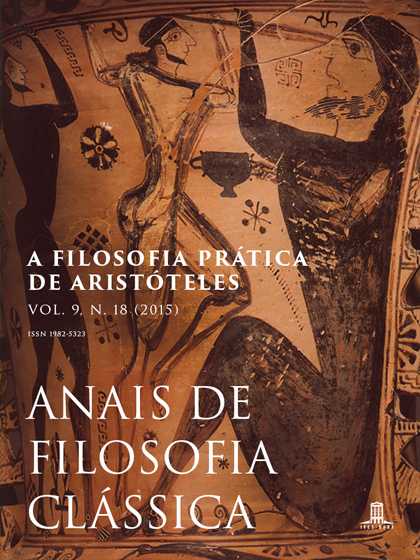Stabilité et instabilité : une tentative d'articulation entre éthique et poétique chez Sénèque
DOI:
https://doi.org/10.47661/afcl.v9i18.4843Palavras-chave:
Sêneca, Poética, Ética, Consciência, SecuritasResumo
A contribuição visa a mostrar como a poética da incerteza e da hesitação se situa, apesar das aparências paradoxais, na continuidade de uma ética da estabilidade (securitas). De fato, na obra filosófica de Sêneca, uma das condições fundamentais para se alcançar a felicidade prevista pela ética da securitas é a innoxia, a ausência de mal realizado a outros. Quando se cometem crimes, a punição está já no ato mesmo, isto é, em nossa consciência. E uma consciência que se conhece criminosa jamais terá uma estabilidade interior. Por consequência, o mal feito e vivido pelos protagonistas das tragédias senequianas parece determinar uma poética da incerteza, caracterizada pela presença da dúvida em um nível temático e estilístico. O discurso poético da tragédia nos parece, pois, complementar ao discurso filosófico e podemos conceber a tragédia como um comentário da obra filosófica.Referências
ALBERTI A. The epicurean theory of law and justice. In: ______. Justice and Generosity: Studies in Hellenistic Social and Political Philosophy: Proceedings of the Sixth Symposium Hellenisticum. Cambridge: Cambridge University Press, 1995, pp. 161-190.
ALBINI U. La storia di Edipo in Seneca. Rivista di Filologia e di Istruzione Classica. Torino, 123, pp. 428-432, 1995.
ALLENDORF T. The poetic of uncertainty in Senecan drama. Materiali e discussioni per l'analisi dei testi classici. Pisa, 71, pp. 103-144, 2013.
ATKINS J. W. Euripides Orestes and the concept of conscience in Greek philosophy. Journal of the History of Ideas. Baltimore (Md.), 75, pp. 1--22, 2014.
BARBERIS G. Curas revolvit animus et repetit metus: osservazioni sulla paura dell'Edipo senecano. Paideia. Brescia, 49, pp. 3-7, 1994.
______. Una punizione al di là della vita e della morte: la poesia della colpa nell'Oedipus. Paideia. Brescia, 51, pp. 161-170, 1996.
CITTI F. Cura sui. Studi sul lessico filosofico di Seneca. Amsterdam: Hakkert, 2012.
______ ET AL. CEdipo classico e contemporaneo. Zürich-New York: Olms, 2012.
DINGEL J. Seneca und die Dichtung. Heidelberg: Carl-Winter Universitätverlag, 1974.
LEFEBVRE R. Représentation, lumière, conscience chez les stoïciennes.Revue des Études Grecques. Paris, 120, pp. 469-483, 1997.
MASTRONADE D. J. Seneca's Oedipus. The drama in the word. Transactions of the American Philological Association. Baltimore (Md.),101, pp. 291-315, 1970.
MAZZOLI G. Seneca e la poesia. Milano: Pubblicazioni della Facoltà di Lettere e Filosofia dell'Università di Pavia. Istituto di Letteratura Latina, Ceschina, 1970.
______. Il gioco delle parti: un tema gnomico senecano e le sue ridondanze metateatrali. Quaderni di cultura e di tradizione classica. Palermo, VIII, pp. 87-100, 1990.
______. Seneca e la poesia. In:______. Sénèque et la prose latine. Neuf exposés suivis de discussions (Vandoeuvres-Genève, 14-18 aout 1991). Genève: Fondation Hardt, 1991, pp. 177-219.
______. Demifisticazione del mito e mitizzazione della storia nello stoicismo di Seneca. In:______. Filosofia, storia, immaginario mitologico. Alessandria: Edizioni dell'Orso, 1997, pp. 149-153.
______. Il tragico in Seneca. Lexis. Amsterdam, 15, pp. 79-91, 1997.
______. Error e culpa nelle tragedie di Seneca. Aevum. Milano, 10, pp. 321-331, 2010.
SCHIESARO A. Seneca's Thyestes and the morality of tragic furor. In:______. Reflections of Nero: culture, history, and representation. Chapel Hill-London: The University of North Carolina Press, 1994, pp. 196-210.
______. Passion, reason and knowledge in Seneca's tragedies. In: ______. The passions in Roman thought and literature. Cambridge: Cambridge University Press, 1997, pp. 89-111.
______. The Passions in Play. Thyestes and the Dynamics of Senecan Drama, Cambridge: Cambridge University Press, 2003.
SCHOFIELD M. The stoic approaches to justice.In: ______. Justice and Generosity: Studies in Hellenistic Social and Political Philosophy: Proceedings of the Sixth Symposium Hellenisticum. Cambridge: Cambridge University Press, 1995, pp. 191-212.
SORABJI R. Moral Conscience trough the ages. Oxford: Oxford University Press, 2014.
STROHM P. Conscience: A Very Short Introduction. Oxford: Oxford University Press, 2011.
C. TORRE. «Alia temptanda est via»: alcune riflessioni sui recenti sviluppi della questione dei «due» Seneca (morale e tragico). Acme. Milano, 60/1, pp. 37-84, 2007.
______. Seneca tragico vs. Seneca filosofo. Nuovi approcci a una vecchia querelle.In:______. La filosofia a teatro. Milano: Cisalpino 2010, pp. 41-61.


